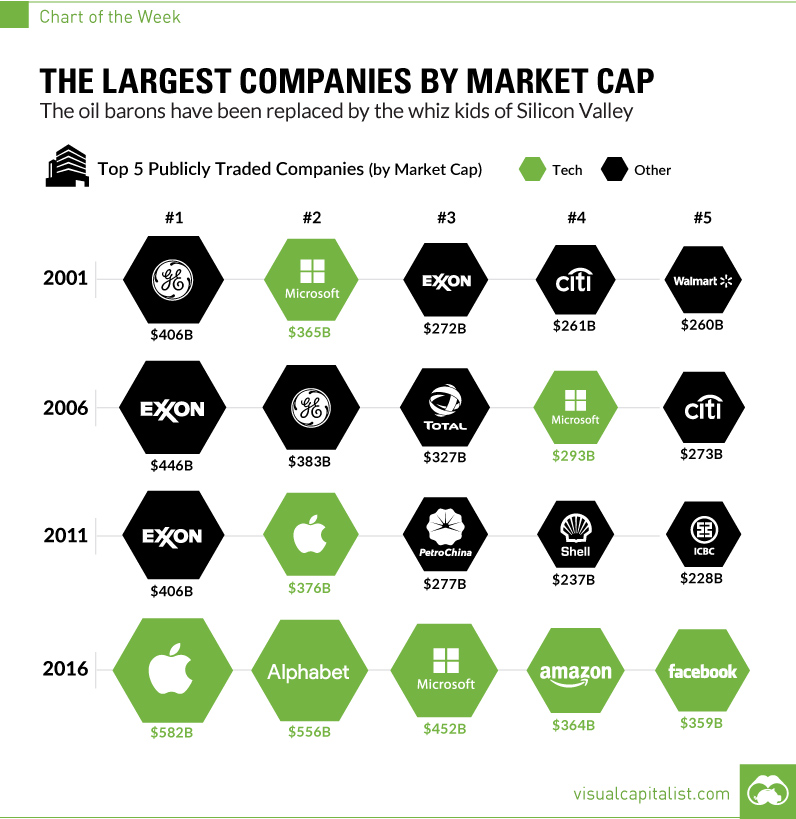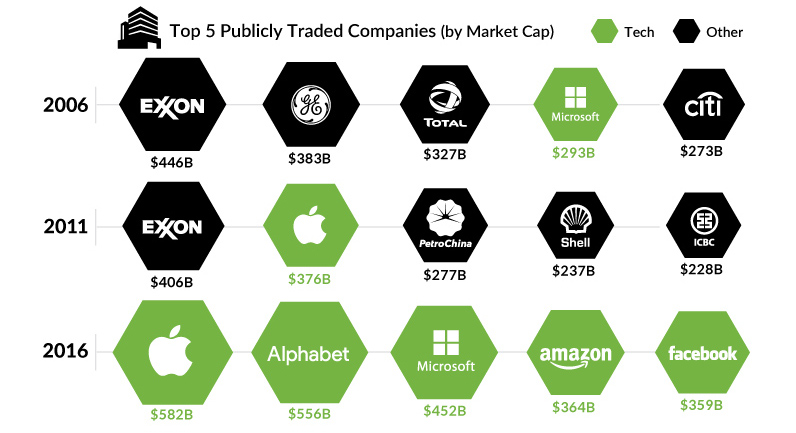Technology
Chart: The Largest Companies by Market Cap Over 15 Years

Chart: The Largest Companies by Market Cap Over 15 Years
The Oil Barons have been replaced by the Whiz Kids of Silicon Valley
The Chart of the Week is a weekly Visual Capitalist feature on Fridays.
By definition, the largest companies by market cap are the most valued by investors in absolute terms.
Of course, these companies change all the time. Secular trends rise and fall, and economic cycles rinse and repeat. New companies are built, while former “blue chips” may struggle. For every Enron that busts, there’s an Amazon shooting up through the ranks.
At the end of the day, however, a snapshot of the largest companies at a given time tells us what the market valued the most. And as this week’s chart shows, this simple data series can also tell us a surprising amount about the macroeconomic story over recent years.
Energy Downturn, Tech Upturn
In 2001, oil was about $30/bbl. Only one oil company (Exxon) cracked the top five list by market cap at the time.
Fast forward a decade, when oil prices soared to the $100/bbl neighborhood. At this point, three of five of the largest companies by market cap were now in the oil business: Exxon, PetroChina, and Royal Dutch Shell.
And today? We are back at $40/bbl and no energy companies crack the top five. Instead, the list has been completely replaced by tech companies, including Apple, Alphabet, Amazon, Facebook, and Microsoft.
Scale is in Style
Well, scale has always been in style, but now it is achievable in ways like never before. To reach more people, Walmart had to build more stores, expand complex supply chains, and hire new employees. This takes a lot of capital and manpower, and the stakes are high for each new expansion.
Amazon on the other hand, can bring in more revenues with less of the work or risk involved. Scale allows tech companies to get bigger without getting bogged down by many of the problems that companies with millions of employees can run into.
The world’s best tech companies are also able to gain competitive advantages that are extremely difficult to supplant. While oil companies are fighting over a limited supply and have a commoditized end product, Google and Facebook have key businesses that are truly unique and the best at what they do.
For these reasons, tech is likely to top the leaderboard for the largest companies by market cap for the foreseeable future.
Technology
Ranked: Semiconductor Companies by Industry Revenue Share
Nvidia is coming for Intel’s crown. Samsung is losing ground. AI is transforming the space. We break down revenue for semiconductor companies.
Semiconductor Companies by Industry Revenue Share
This was originally posted on our Voronoi app. Download the app for free on Apple or Android and discover incredible data-driven charts from a variety of trusted sources.
Did you know that some computer chips are now retailing for the price of a new BMW?
As computers invade nearly every sphere of life, so too have the chips that power them, raising the revenues of the businesses dedicated to designing them.
But how did various chipmakers measure against each other last year?
We rank the biggest semiconductor companies by their percentage share of the industry’s revenues in 2023, using data from Omdia research.
Which Chip Company Made the Most Money in 2023?
Market leader and industry-defining veteran Intel still holds the crown for the most revenue in the sector, crossing $50 billion in 2023, or 10% of the broader industry’s topline.
All is not well at Intel, however, with the company’s stock price down over 20% year-to-date after it revealed billion-dollar losses in its foundry business.
| Rank | Company | 2023 Revenue | % of Industry Revenue |
|---|---|---|---|
| 1 | Intel | $51B | 9.4% |
| 2 | NVIDIA | $49B | 9.0% |
| 3 | Samsung Electronics | $44B | 8.1% |
| 4 | Qualcomm | $31B | 5.7% |
| 5 | Broadcom | $28B | 5.2% |
| 6 | SK Hynix | $24B | 4.4% |
| 7 | AMD | $22B | 4.1% |
| 8 | Apple | $19B | 3.4% |
| 9 | Infineon Tech | $17B | 3.2% |
| 10 | STMicroelectronics | $17B | 3.2% |
| 11 | Texas Instruments | $17B | 3.1% |
| 12 | Micron Technology | $16B | 2.9% |
| 13 | MediaTek | $14B | 2.6% |
| 14 | NXP | $13B | 2.4% |
| 15 | Analog Devices | $12B | 2.2% |
| 16 | Renesas Electronics Corporation | $11B | 1.9% |
| 17 | Sony Semiconductor Solutions Corporation | $10B | 1.9% |
| 18 | Microchip Technology | $8B | 1.5% |
| 19 | Onsemi | $8B | 1.4% |
| 20 | KIOXIA Corporation | $7B | 1.3% |
| N/A | Others | $126B | 23.2% |
| N/A | Total | $545B | 100% |
Note: Figures are rounded. Totals and percentages may not sum to 100.
Meanwhile, Nvidia is very close to overtaking Intel, after declaring $49 billion of topline revenue for 2023. This is more than double its 2022 revenue ($21 billion), increasing its share of industry revenues to 9%.
Nvidia’s meteoric rise has gotten a huge thumbs-up from investors. It became a trillion dollar stock last year, and broke the single-day gain record for market capitalization this year.
Other chipmakers haven’t been as successful. Out of the top 20 semiconductor companies by revenue, 12 did not match their 2022 revenues, including big names like Intel, Samsung, and AMD.
The Many Different Types of Chipmakers
All of these companies may belong to the same industry, but they don’t focus on the same niche.
According to Investopedia, there are four major types of chips, depending on their functionality: microprocessors, memory chips, standard chips, and complex systems on a chip.
Nvidia’s core business was once GPUs for computers (graphics processing units), but in recent years this has drastically shifted towards microprocessors for analytics and AI.
These specialized chips seem to be where the majority of growth is occurring within the sector. For example, companies that are largely in the memory segment—Samsung, SK Hynix, and Micron Technology—saw peak revenues in the mid-2010s.
-

 Markets2 weeks ago
Markets2 weeks agoVisualizing America’s Shortage of Affordable Homes
-

 Technology1 week ago
Technology1 week agoRanked: Semiconductor Companies by Industry Revenue Share
-

 Money1 week ago
Money1 week agoWhich States Have the Highest Minimum Wage in America?
-

 Real Estate1 week ago
Real Estate1 week agoRanked: The Most Valuable Housing Markets in America
-

 Business1 week ago
Business1 week agoCharted: Big Four Market Share by S&P 500 Audits
-

 AI2 weeks ago
AI2 weeks agoThe Stock Performance of U.S. Chipmakers So Far in 2024
-

 Automotive2 weeks ago
Automotive2 weeks agoAlmost Every EV Stock is Down After Q1 2024
-

 Money2 weeks ago
Money2 weeks agoWhere Does One U.S. Tax Dollar Go?










